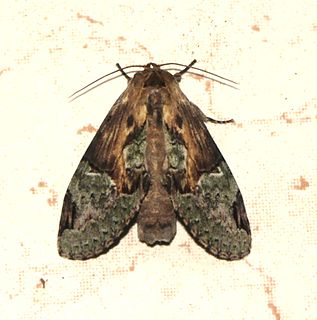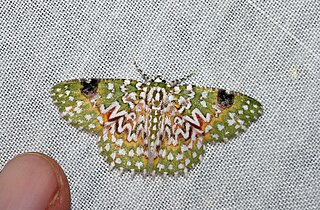
Phragmataecia castaneae, the reed leopard or giant borer, is a moth of the family Cossidae. It was described by Jacob Hübner in 1790. It is found in central and southern Europe, the Middle East, the Caucasus, Transcaucasia, Turkmenistan, Kazakhstan, north-western Iran, Iraq, Syria, Sri Lanka, Madagascar, India, Lebanon, Turkey, western China, south-western Siberia, Egypt, Tunisia and Morocco.

Cephonodes hylas, the coffee bee hawkmoth, pellucid hawk moth or coffee clearwing, is a moth of the family Sphingidae. The species was first described by Carl Linnaeus in 1771. A widely distributed moth, it is found in the Near East, Middle East, Africa, India, Sri Lanka, Japan, Southeast Asia and Australia.

Eudocima phalonia, the common fruit-piercing moth, is a fruit piercing moth of the family Erebidae. The species was first described by Carl Linnaeus in his 1763 Centuria Insectorum. It is found in large parts of the tropics, mainly in Asia, Africa and Australia but introduced into other areas such as Hawaii, New Zealand and the Society Islands. It is one of major fruit pests in the world.

Acronicta pruinosa is a moth of the family Noctuidae. It is found in Sri Lanka, the Himalaya, east to Japan and Taiwan south to Myanmar and Peninsular Malaysia, Borneo, Java and New Guinea.

Chadisra bipars is a moth of the family Notodontidae. It was described by Francis Walker in 1862 and is found in the Indomalayan realm.

Eucyclodes gavissima, the Oriental orange banded green geometer moth, is a species of moth of the family Geometridae described by Francis Walker in 1861. It is found in the Indian subregion, Sri Lanka, Bhutan, western China, Taiwan, Sumatra and Borneo.

Theretra pallicosta, the white-edged hunter hawkmoth, is a moth of the family Sphingidae described by Francis Walker in 1856. It is found from Sri Lanka and India, east through Nepal, Bangladesh and Myanmar to Hong Kong and Taiwan and south through Thailand, Laos and Vietnam to Peninsular Malaysia and Indonesia.

Oraesia emarginata is a species of moth of the family Erebidae first described by Johan Christian Fabricius in 1794. It is found in Australia, New Caledonia, Indonesia, New Guinea, Pakistan, the Philippines, India, Sri Lanka, Sulawesi, Taiwan, China, Japan, Korea and Nepal as well as Eritrea, Ethiopia, Kenya, Namibia, Nigeria, South Africa, Tanzania, the Gambia, Uganda, Oman and Yemen.

Scirpophaga incertulas, the yellow stem borer or rice yellow stem borer, is a species of moth of the family Crambidae. It was described by Francis Walker in 1863. It is found in Afghanistan, Nepal, north-eastern India, Sri Lanka, Bangladesh, Myanmar, Vietnam, Thailand, Malaysia, Singapore, Sumatra, Java, Borneo, Sumba, Sulawesi, the Philippines, Taiwan, China and Japan.
Ancylolomia chrysographellus, the angled grass moth, is a species of moth in the family Crambidae. It is found on Cyprus and in Kenya, Uganda, Yemen, India, Pakistan, Sri Lanka, Myanmar, China, Korea, Japan, Taiwan, the Philippines and Indonesia.

Adrapsa ablualis is a species of moth in the family Noctuidae that can be found in Queensland in Australia and in Southeast Asia. It was first described by Francis Walker in 1859.
Garudinia latana is a moth of the family Erebidae first described by Francis Walker in 1863. It is found in Sri Lanka.
Calamotropha atkinsoni is a moth in the family Crambidae. It was described by Philipp Christoph Zeller in 1863. It is found in south-east Asia, where it has been recorded from India, Sri Lanka, Thailand, Singapore and Sulawesi.
Chilo ceylonica is a moth in the family Crambidae. It was described by George Hampson in 1896. It is found in Sri Lanka, Vietnam and Hainan, China.
Mesolia pandavella is a moth in the family Crambidae. It was described by Émile Louis Ragonot in 1889. It is found in India and Sri Lanka.
Patissa lactealis is a moth in the family Crambidae. It was described by Cajetan Felder, Rudolf Felder and Alois Friedrich Rogenhofer in 1875. It is found in Sri Lanka.
Scirpophaga gilviberbis is a moth in the family Crambidae. It was described by Philipp Christoph Zeller in 1863. It is found on the Comoros and in the Democratic Republic of the Congo, Kenya, South Africa, Zambia, India, Indonesia, Myanmar, Singapore, Thailand and Vietnam.
Patissa curvilinealis is a moth in the family Crambidae. It was described by George Hampson in 1896. It is found in Sri Lanka.
Epiricania melanoleuca is a moth in the family Epipyropidae. It was described by Thomas Bainbrigge Fletcher in 1939. It is found in India, where its larvae are external parasitoids of the sugarcane planthopper. It has been used in biological pest control against this pest.
Streblote dorsalis is a moth of the family Lasiocampidae first described by Francis Walker in 1866. It is found in India, Sri Lanka, the Philippines, Borneo, Indonesia and Java.








